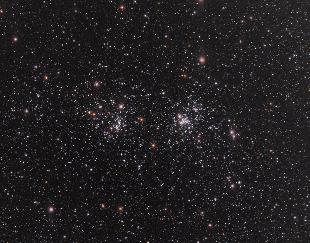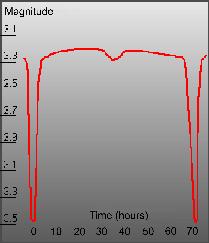Perseus
C14 - The Double Cluster
Algol - Eclipsing Binary Star
Perseus lies along the plane of the Milky Way, but as we view it, we are looking away from the galactic centre, so that there are fewer clusters within its boundaries than when looking towards Sagattarius or Scorpius. However, the two clusters that form the Perseus Double Cluster provide one of the best binocular sights in the heavens and Perseus also harbours a very interesting star system, Algol. Whilst, for northern observers, Perseus comes high overhead in the latter months of the year, for southern observers it only just rises above the northern horizon so that, whilst they should be able to observe Algol, sadly, the Double Cluster will lie below their horizon.
C14 - Twin Open Clusters B M
Visible to the unaided eye as a hazy patch in the Milky Way, binoculars or a small telescope at low power can show both these two beautiful clusters in the same field of view. They are most easily found by sweeping with your eyes, binocular or finder scope to the east and a little south of Cassiopeia, following the line set by its bright stars Gamma and Delta. The bright cores of the two clusters are separated by just less than one Moon diameter, 25 arc minutes, and together they cover over a degree of sky. Given their separation and individual visual brightness of between 4th and 5th magnitude, one should be able to see them as separate entities. But this is not usually the case. Surprisingly perhaps, the best chance to do so is by observing them just as twilight ends; when they first appear to the eye but the background stars of the Milky Way are still invisible. (In a similar fashion, the brighter stars of constellation - those that form the patterns that we learn - show up far more clearly under twilight or light-polluted conditions than when seen in really dark conditions. This is why you are advised to learn the shapes and locations of the constellations when the sky conditions are not too good!) The two clusters, also known as h and Chi Persei, are a beautiful sight in 10x50 binoculars; each cluster having a bright centre and many individually resolved stars. With a low-power eyepiece both can be seen in the same field and then, moving up to medium power, each can be observed in detail. They lie in the Perseus spiral arm of the Milky Way some 7300 light years away, and were both formed about 3 million years ago.
Position: 2h 20.5m +57deg 08min
Algol - Eclipsing Binary Star E B
Algol is one of the most remarkable and most famous individual stars in the sky. Its Arabic name is Al Ghul, which means the 'demon' star (Ghul is related to 'ghoul', a ghost). Why a demon? Because it winks! Every 2.87 days its brightness quickly drops from magnitude 2.1 to 3.4 and then rises again to 2.1 over a period of 10 hours. John Goodricke of York was one of the first astronomers who discovered its regular brightness variations in 1782–3. Much later, in 1881, astronomers realised that the effect could be caused by a binary system in which the orbital plane of the two stars was almost in line with the Earth, so that every 2.87 days there is a partial eclipse! This is when the fainter star of the two comes in front of the brighter. In between each major drop in brightness, there is a much smaller drop as the brighter star comes in front of the fainter. The primary star is a blue B-type star with a surface temperature of 12,000K. The secondary is a much larger but dimmer K-type orange giant star. Interestingly, the two stars do not seem to be following the normal rules of stellar evolution. More massive stars evolve faster than less massive ones, so the orange giant - which has evolved away from the main sequence - should be more massive than the blue primary star. But it has less mass! It appears that material may be flowing from the giant star (so reducing its mass) onto the normal star whose mass is thus increasing.
Position: 3h 8.2m +40deg 57min





